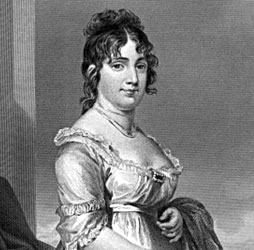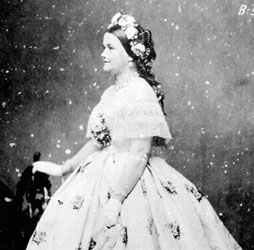By Charity Montieth/managing editor
Behind every great man is a great woman even when that man happens to be president, and residents of the White House have proved that for more than 200 years.
Martha Washington (1731-1802) As the first first lady, Martha Washington’s primary role was entertaining guests and dignitaries. Her formal, but warm style set the tone still followed today. As a widow with two young children, Martha married George Washington in 1759 primarily to ensure their well-being. Being married to the father of our country was an uncomfortable position for her, and she often wrote she would prefer to maintain a quiet life. In spite of her uneasiness, she handled her role as First Lady with grace and poise. “I have also learned from experience that the greater part of our happiness or misery depends upon our dispositions, and not upon our circumstances,” she wrote to Abagail Adams.

Dolley Madison (1768-1849) Credited with saving a portrait of George Washington from destruction in 1814, Dolley Madison is one of the country’s most beloved first ladies. Dolley’s gentle humor charmed visitors, making the White House the country’s social center even after it was nearly destroyed by fire after a British invasion during the War of 1812.
Rachel Jackson (1767-1828) Two years after marrying Andrew Jackson, the couple learned Rachel was not divorced from her first husband, Lewis Robards. Making matters worse, Robards charged the couple with adultery and bigamy. Although a judge ruled the incident an honest mistake, rumors and scandal seemed to follow the couple as Jackson’s political career advanced. Jackson was fiercely protective of his honor and often engaged in duels, even killing a man who unjustly criticized Rachel.
Sarah Polk (1803-1891) As first lady, Sarah Polk was not satisfied to settle into a life of graceful entertaining. Instead, she took an interest in the country’s politics and was known for her sharp mind. It was not uncommon for her to accompany her husband, James K. Polk, on trips to Washington. She privately assisted with writing speeches, copying correspondence and offering advice. Even after the Polks left the White House, she held herself above sectional strife and met with leaders of both the Confederate and Union armies. She was respected among both sides as rare neutral ground.
Harriet Lane (1830-1903) Harriet Lane served as first lady for the only president to never marry. She took on the role as White House hostess for her uncle and guardian, James Buchanan. Lane was dubbed “the Democratic Queen” for her ability to entertain tactfully, even among rising tensions that eventually led to the secession of seven states and the Civil War.

Mary Todd Lincoln (1818-1882) Although “Honest Abe” is one of America’s most beloved presidents, Mary was a misunderstood and tragic first lady. Mary, who reportedly suffered from severe depression, shied away from social gatherings and was highly criticized. Being born in the South, she was viewed by many as a “traitor.” She was shattered by the assassination of Lincoln and for many years was tormented by a paranoia that she, too, would be murdered.
Lucy Hayes (1831-1889) During Rutherford Hayes’ days in the military, Lucy was affectionately known as “Mother Lucy.” When Hayes took office, that moniker quickly transitioned to “Lemonade Lucy” when the press learned Lucy refused to serve alcohol in the White House. Lucy took the criticism with good humor, and soon the press grew to love her, eventually dubbing her as representative of the “new woman era.”
Anna Eleanor Roosevelt (1884-1962) Eleanor Roosevelt is credited with changing the role of first lady from social entertainment to political involvement. When Franklin and Eleanor Roosevelt came to the White House in 1933, she had a vast understanding of world social conditions. She broke precedent by holding press conferences, making radio broadcasts and giving speeches. This open involvement made her a target for media and political enemies, but she remained confident, graceful and poised delivering her messages.
Jacqueline Bouvier Kennedy (1929-1994) Jackie Kennedy is remembered for bringing beauty, intelligence and cultivated taste to the White House. John Kennedy’s presidency was the first in which television cameras played a major role, and Jackie became one of America’s first “pop icons.” She devoted hours to making the White House a museum of American history, and her renovations combined historic artwork with elegant charm.
Rosalynn Smith Carter (1927- ) A skillful speaker, Rosalynn Carter was a hard worker during Jimmy Carter’s administration. She focused attention on the arts, mental health, community programs and the elderly. In 1982, the Carters founded The Carter Foundation to promote peace, human rights, global health and democracy throughout the world. Rosalynn still works to diminish the stigma of mental illness and promote greater access to mental health care.
Nancy Reagan (1921- ) The love story of Ronald and Nancy Reagan has been highly publicized, and she selflessly stood beside her husband through his battle with Alzheimer’s. During their time at the White House, Nancy launched the “Just Say No” program to prevent drug use among young children. She also worked with charitable groups to support veterans, the elderly and mentally and physically disabled.
Hillary Rodham Clinton (1947- ) During Bill Clinton’s administration, controversy abounded; however, Hillary was tireless in her support of women and children. Her active role began in 1993 as chair of the Task Force on National Health Care Reform. She continues to advocate for expanding health insurance coverage, ensuring children are properly immunized and raising public awareness of health issues. She was elected Senator from New York on Nov. 7, 2000, the first first lady elected to the Senate and the first woman elected statewide in New York. Recently announcing candidacy for the 2008 presidency, she is considered a Democratic Party top contender.
